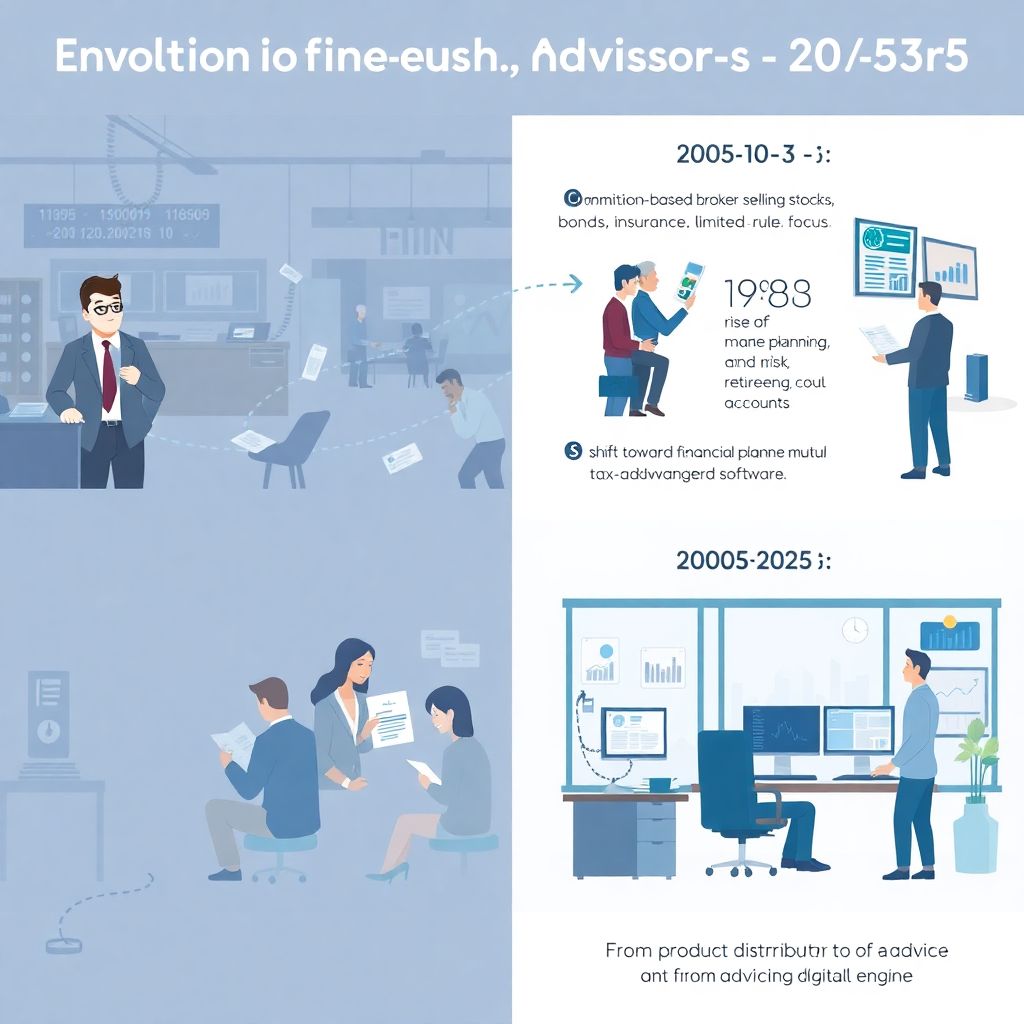Historical Background of Financial Advice
For most of the 20th century, the typical “financial advisor” was essentially a broker selling stocks, bonds and insurance products for a commission. Consumer choice was narrow, data was scarce, и regulatory oversight focused more on trading rules than on holistic planning. From the 1980s, with the rise of mutual funds and tax‑advantaged retirement accounts, clients started asking broader questions about goals, risk and long‑term projections, not just “What stock should I buy?”. That shift pushed the market toward financial planning as an integrated service. Professional standards slowly followed: designations such as CFP, more rigorous suitability rules, and then fiduciary obligations for specific accounts. By 2025, the role has evolved from product distributor to advice engineer, combining behavioral finance, risk modeling and digital tools to structure coherent life‑cycle strategies rather than isolated transactions.
Core Principles of Selecting an Advisor
Regulation, Fiduciary Duty and Professional Standards
When you think about how to choose a financial advisor, the first filter is not personality but legal obligation. A fiduciary advisor is required to put your interests ahead of their own, document their rationale and disclose conflicts in plain language. Non‑fiduciary brokers may operate under a looser “suitability” standard, where a product only has to be considered reasonable, not optimal. In practice, this difference shapes portfolio construction, insurance recommendations and tax strategies over decades. Credentials add another layer: designations like CFP or CFA indicate structured education and ongoing ethics oversight, while unregulated titles like “wealth coach” or “money guru” reveal little. In 2025, you can verify licenses and disciplinary history through regulator databases in minutes, so skipping this due diligence is effectively choosing to fly blind in a high‑stakes environment.
Compensation Models and Conflict Management
Compensation architecture is the second core principle, because it quietly defines much of the advisor’s incentive landscape. Fee only financial advisor services typically charge a percentage of assets under management, hourly consulting fees, or fixed project retainers, minimizing dependence on product commissions. Hybrid and commission‑based models can still work, but they demand sharper questioning from clients about embedded loads, revenue‑sharing and ongoing trails. Independent financial planner costs may appear higher on the surface because they are itemized, whereas commissions are often buried in product pricing; however, transparent fees make total economic value easier to compare across providers. The goal is not to find the cheapest option at all costs but to align the fee structure with the complexity of your situation, the required time horizon and your need for continuous monitoring, rebalancing and behavioral coaching through volatile markets.
Practical Implementation Examples
Early‑Career Professional Building a Foundation

Consider a 30‑year‑old software engineer carrying student debt, equity compensation and ambitions for early financial independence. This client benefits from a planner who can integrate cash‑flow analysis, debt amortization, tax‑efficient exercise of stock options and an appropriate risk budget for long‑term investing. In this scenario, ongoing asset‑based fees may be disproportionate if investable assets are still modest, so an hourly or project‑based engagement can be more capital‑efficient. The search process might start online with a “financial advisor near me” query, but the real screening happens in discovery calls, asking how the advisor models equity compensation, stress‑tests savings rates and coordinates with tax professionals. A well‑structured engagement will produce a detailed implementation roadmap, including automated savings targets, rebalancing triggers and guardrails for lifestyle inflation that can derail compounding if left unchecked.
Pre‑Retiree Optimizing the Transition Phase

Now imagine a 58‑year‑old couple within seven years of leaving full‑time work, holding diversified portfolios across taxable accounts, 401(k)s and IRAs, plus a partially funded health savings account. For them, the best financial advisors for retirement planning are those who can integrate sequence‑of‑returns analysis, Social Security claiming strategies, Medicare premium impacts and multi‑decade longevity risk into a coherent decumulation plan. Tax‑aware withdrawal sequencing becomes central: choosing whether to harvest from taxable accounts, Roth buckets or traditional IRAs in a given year can materially alter lifetime after‑tax wealth. Here, an assets‑under‑management fee may be more sensible, because the advisor is continuously adjusting allocation and withdrawal policy as markets move and regulations change. Scenario modeling around bear markets in the first five retirement years and varying inflation assumptions helps the couple calibrate spending ceilings rather than relying on crude rules of thumb like a fixed four‑percent withdrawal rate.
Business Owner and Complex Balance Sheet
A privately held business adds several layers of complexity: concentrated equity risk, irregular cash flows, succession issues and interaction with both corporate and personal tax regimes. An advisor in this case functions as an integrator across law, accounting and insurance, coordinating entity structure, buy‑sell agreements and liquidity planning around a future exit. Instead of focusing solely on investment product selection, the engagement emphasizes enterprise valuation, creditor protection, key‑person coverage and strategies to diversify away from a dominant operating asset without damaging control or culture. The advisor’s toolkit may include advanced estate planning instruments, deferred compensation schemes and staged sale structures, so the client must assess both technical depth and the ability to manage multi‑disciplinary teams. Transparent discussion of scope, retainer structure and performance metrics keeps the relationship grounded in measurable outcomes rather than vague promises of “holistic wealth management” that are difficult to audit in practice.
Common Misconceptions and Cognitive Traps

One persistent illusion is that past portfolio performance is a reliable predictor of future advisory value, leading clients to chase recent winners instead of interrogating process, risk controls and discipline. Another frequent misunderstanding involves fees: investors often underestimate total costs by focusing on visible advisory charges while ignoring fund expense ratios, transaction spreads and embedded insurance commissions. Misreading independent financial planner costs as purely overhead can push people toward “free” or low‑touch options that monetize them in less transparent ways, such as order‑flow arrangements or product cross‑selling. There is also a myth that robo‑advisors make human expertise obsolete; in reality, algorithms excel at standardized portfolio tasks but struggle with nuanced trade‑offs among family dynamics, business constraints and personal risk tolerances. Overconfidence compounds these issues, as do confirmation bias and social proof, so consumers benefit from structured decision frameworks instead of relying on anecdotes from friends or charismatic media personalities.
Future Outlook: Evolution of Advisor Selection to 2035
By 2035, selecting an advisor will likely feel more like evaluating a specialized software stack plus human strategist than choosing a traditional salesperson. Expect pervasive use of machine‑learning tools for tax‑loss harvesting, liability matching and behavioral pattern detection, with advisors differentiating themselves through interpretation rather than raw calculation. Regulation will probably tighten around disclosure, standardizing metrics so clients can compare risk‑adjusted outcomes and service levels across firms more efficiently. Advisors will be pushed to document not only investment rationales but also their methodology for personalized financial planning, from life‑event modeling to scenario‑based stress testing. For consumers, the practical question will shift from “Who seems trustworthy?” to “Which advisory architecture integrates best with my digital ecosystem and governance preferences?”. Guidance on how to choose a financial advisor will therefore emphasize data‑sharing protocols, AI‑assisted analytics and robust cyber‑security guarantees, alongside the timeless issues of ethics, competence and transparent economic alignment.

